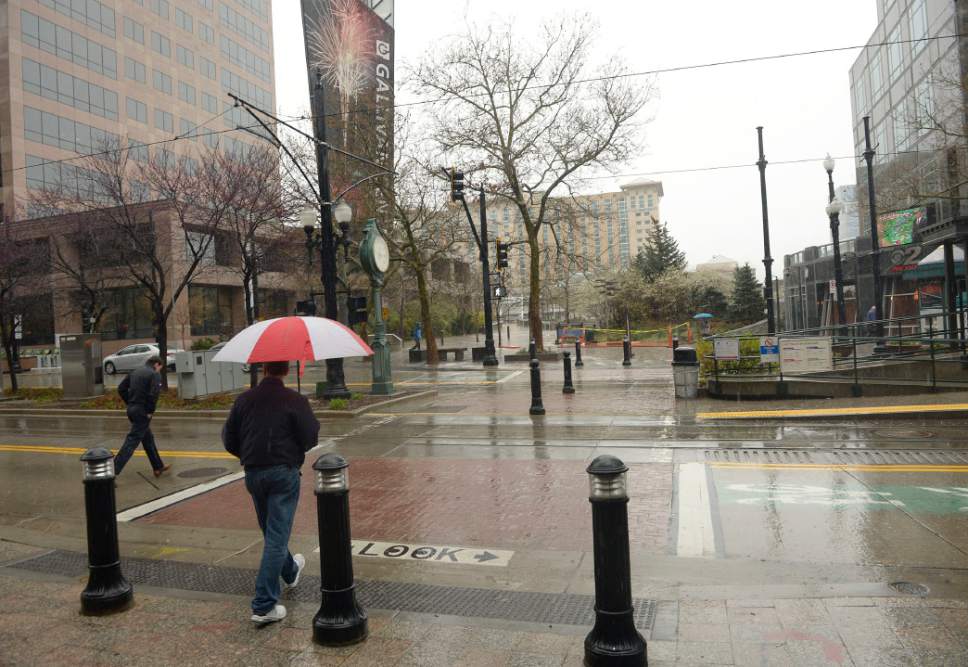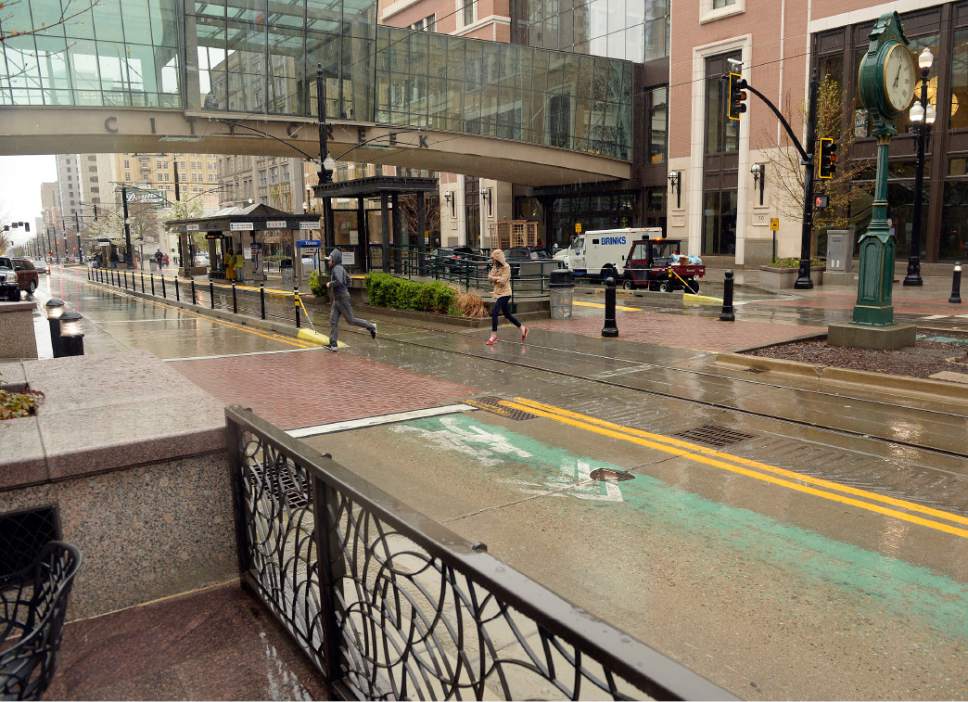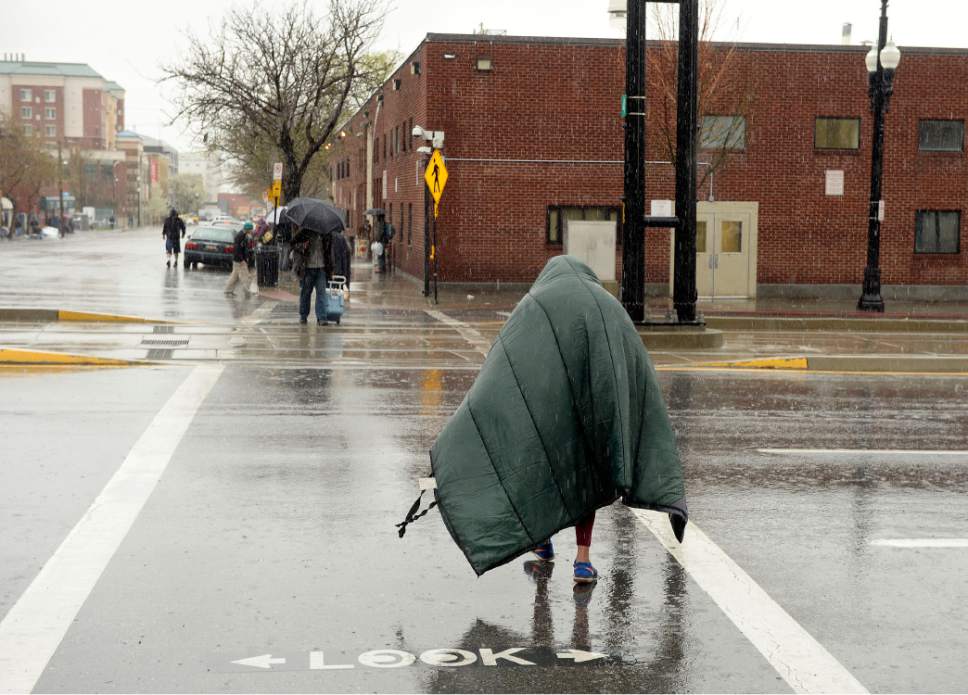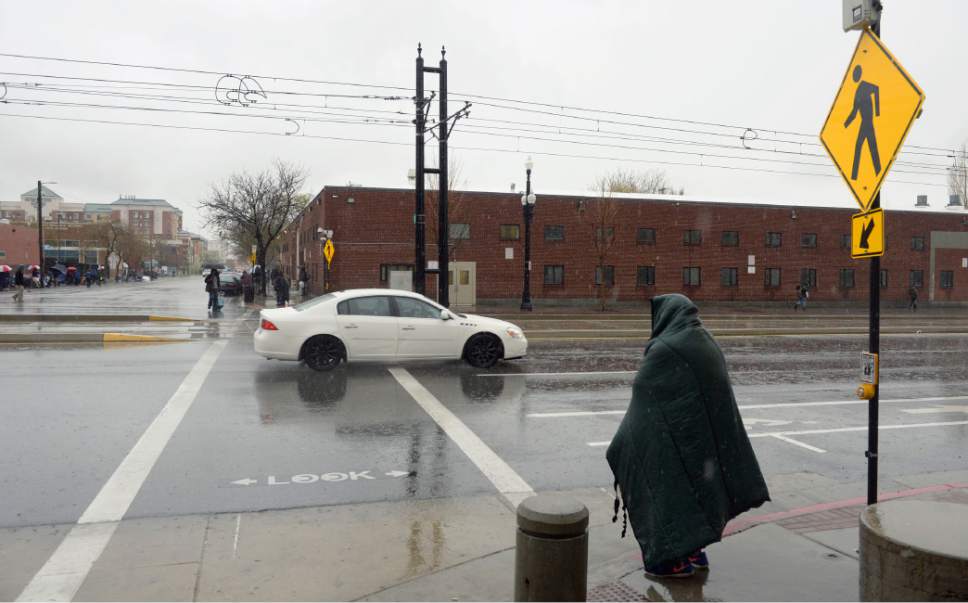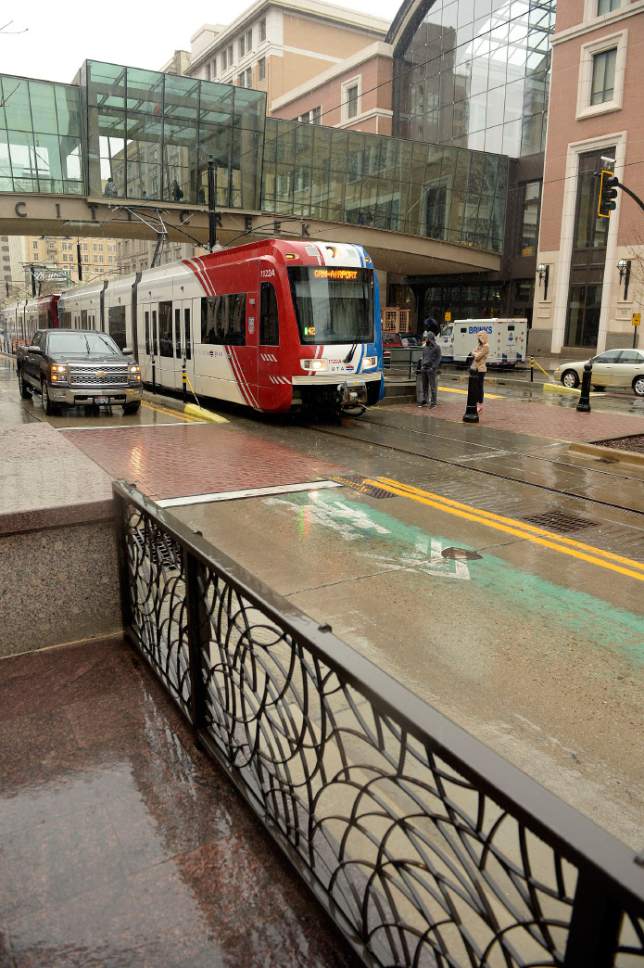This is an archived article that was published on sltrib.com in 2017, and information in the article may be outdated. It is provided only for personal research purposes and may not be reprinted.
Salt Lake City and Utah Transit Authority officials insist their plan to install a 5-foot-tall chain-link fence in the median of 200 South — and close a midblock pedestrian crossing there — is all about preventing train or bus accidents involving pedestrians.
But documents obtained by The Salt Lake Tribune through open-records requests show that other light-rail stations have more pedestrian-safety problems.
That suggests that the blocklong project between 400 West and 500 West also has plenty to do with creating a barrier between the crowds of homeless people who gather at the Rio Grande Street shelter and The Gateway mall, whose owners urged erection of the fence.
Among the documents:
• UTA's data show that five other TRAX stations (also located in the middle of streets like the Old Greektown Station on 200 South near the planned fence) have more close calls between trains and jaywalkers than Old Greektown, yet no safety upgrades are planned there. Improvements have been made at two stations with as many or more incidents: the Library and City Center stations.
• UTA also developed data about how many times buses on 200 South had "emergency braking" to avoid pedestrians (onboard cameras are triggered anytime that happens). It found five in the past year. But it appears that no such figures were compiled for comparison with other areas.
• Emails between UTA and city officials saying closure of the midblock pedestrian crossing on 200 South at Rio Grande Street is "temporary." Once the nearby shelter is closed, as is now planned, the crossing may reopen.
—
Responsive government • City spokesman Matthew Rojas says the city started pursuing the project at the request of Vestar, Gateway's new owner, which is spending millions to make over the mall.
That's not unusual, according to Rojas. The city often reacts to problems brought to its attention by businesses or neighbors. Residents on 600 North, for example, complained recently that speeds are too fast there, so the city is working to lower them.
"None of this is about making it harder for those experiencing homelessness to enter The Gateway," he said. "It has always been about safety."
UTA says it, too, is responsive to community concerns.
"When UTA is asked to make a legitimate safety improvement by a city or stakeholder, if possible, we will always take the opportunity to make that improvement," said David Goeres, chief safety officer for the agency.
UTA has estimated the cost of installing the vinyl-coated see-through fence at $42,000, although some emails say it could be as high as $54,000. The city also will spend several thousand dollars on the project — emails suggested that could be up to $15,000 — to alter striping and signs along the street.
Vestar issued a statement earlier this month after KUTV-Channel 2 first disclosed the fence-building project, saying it had been concerned about public safety, and "it's our job to be diligent in ensuring the safety of our patrons."
—
Bigger needs elsewhere? • Data from UTA suggest that other areas may have more serious problems between TRAX trains and jaywalkers than 200 South.
Old Greektown station on 200 South — immediately west of the area to be fenced — had three incidents of emergency braking because of pedestrians last year.
Five other stations or spots in the middle of a road had more such close calls — three of them at least double the number at Old Greektown. Gallivan Plaza on Main Street had eight emergency braking incidents, while six each were registered at 1940 W. North Temple, 900 South and Jackson/Euclid stations. Courthouse Station had five. Three other locations had the same number of emergency braking incidents as Old Greektown: Trolley Station, 700 S. West Temple and 200 W. 700 South.
Documents list no improvements planned at those other stations.
Safety features have been installed at two stations with as many or more incidents as Old Greektown: the Library and City Center stations. But the City Center Station, at City Creek Center mall on Main Street, uses cables and decorative metal barriers to funnel pedestrians to a midblock crossing.
Goeres said UTA puts up safety fences when a local government or other stakeholder requests them, and it is determined that a legitimate safety issue exists. He said UTA "confirmed the safety risk to pedestrians" on 200 South.
He said one reason the location may have had fewer instances of emergency braking — even though it has a lot of jaywalking — is that "train and bus operators had already taken the step of going slower than usual" there. "The safety concerns still exist."
UTA also looked at emergency braking by buses in the Old Greektown area — and found five in the past year. An open-records request by The Tribune sought similar data about the entire bus system. None was provided. But Goeres said, "UTA's safety department is always examining areas where buses and trains make emergency stops."
Rojas said UTA reviewed the city's request "for months and months and months" before determining officially that a legitimate safety concern exists. "In all honesty, we're glad there has not been an accident yet."
—
Midblock closure • One controversial aspect of the project is closure of the midblock pedestrian crossing near the shelter.
City Councilman Derek Kitchen, for one, was cautiously critical of this part of the proposal, saying it goes against city planning goals. He would rather see fencing that steers people to use the designated crossing. He also worried about potential discrimination and asked for safety data justifying the move.
Rojas said the plan is sound.
"There was concern that leaving the midblock crossing without a light, we may have individuals who may or may not get stuck between the fences," Rojas said.
He added that if a signal were placed there, it could back up TRAX trains well into a turn they make off of 400 West onto 200 South, "which wouldn't be a viable option."
A midblock signal for pedestrians is operating at City Creek Center, near where TRAX trains similarly make a turn off South Temple onto Main Street.
Rojas said the city is not trying to create a barrier for the homeless, pointing to protected crosswalks "a half a block to the east, and a half a block to the west" to enter Gateway.
Some emails make clear that the midblock closure is considered temporary — and would disappear when the homeless shelter does. Officials hope to replace it in the next two years or so with three new homeless resource centers.
"Even though we are calling this a temporary closure, it may be in for a while so we want fencing that is more aesthetically pleasing" than the plain aluminum links originally proposed, Salt Lake City official Kevin Young wrote in an email to UTA Chief Development Officer Steve Meyer. Vinyl-coated fencing is now planned.
The same email said, "The design of the fencing should be such that the sections at the crosswalk can be easily removed in the future."
Mike Reberg, director of the city's Department of Community and Neighborhoods, also wrote in an email, "When conditions in the area change as new resource centers come online in other parts of the city, it may be possible to review this decision."
Asked about such descriptions, Rojas said, "The shelter and the day services on Rio Grande are absolutely part of the reason why the fence is necessary. It's because the services there are what create an increased population, more people."
He added, "It is because there are more people there along with trains and heavy bus traffic that you increase the risk of people jaywalking." When the shelter closes, he says, not as many people may be in the area, and the city could then re-evaluate the pedestrian crossing.
—
Sad but true • Pamela Atkinson, well-known advocate for the homeless, says she has mixed feelings about the fence — disliking placing a barrier, but seeing a need for safety and realizing it may help stop some homeless people from scaring away Gateway shoppers.
"I don't like fences to keep people out of public spaces," she said.
But she notes she drives on 200 South often, "and I do brake a number of times" for homeless people in the street. "There is a fair amount of jaywalking there. Some of the people are jaywalking under the influence of drugs or alcohol."
She added, "I also know of instances of some of the homeless going over into the mall. Some are panhandling and some are harassing. ... I wish we didn't have that kind of behavior that necessitated a fence."
The fence may boost safety and help attract more Gateway shoppers, she said, "but it makes me sad."


